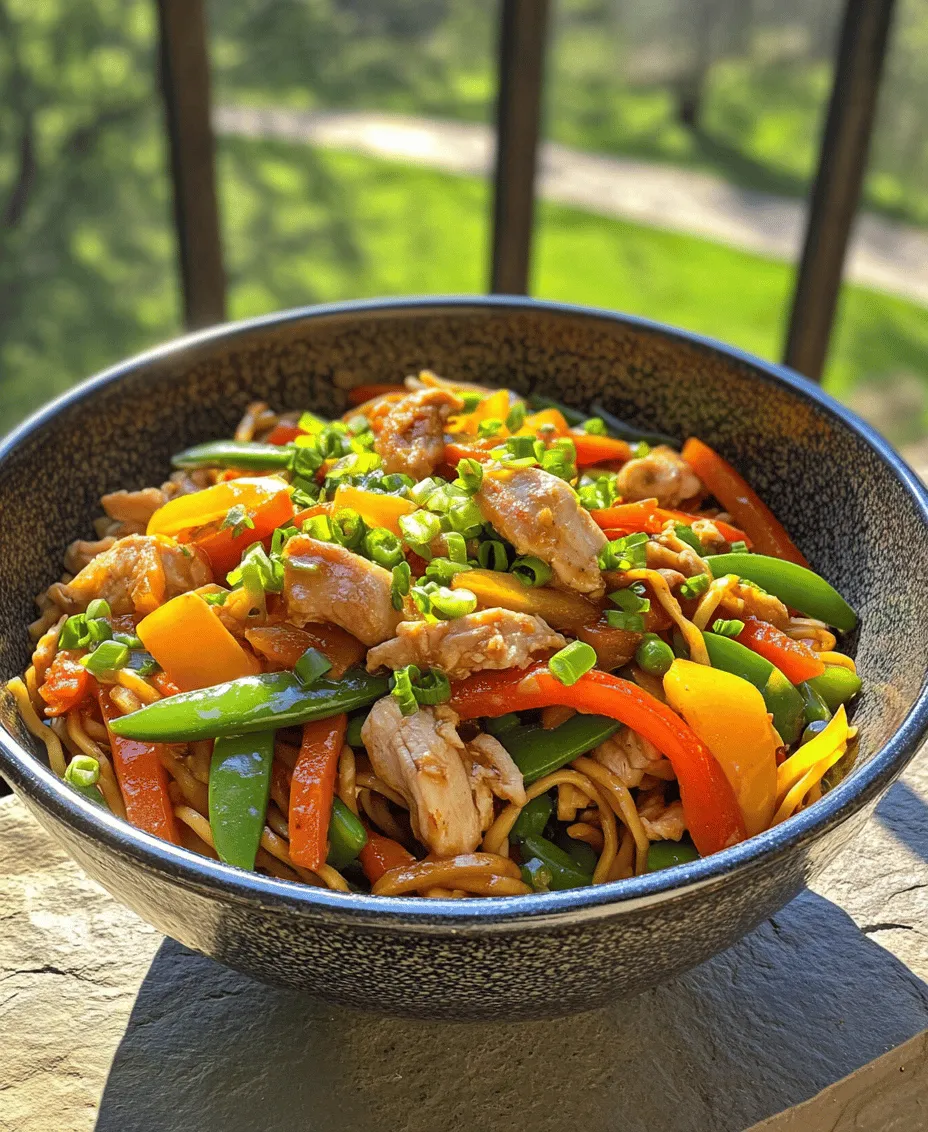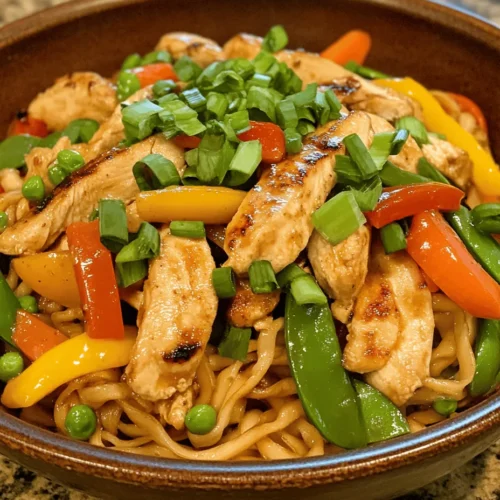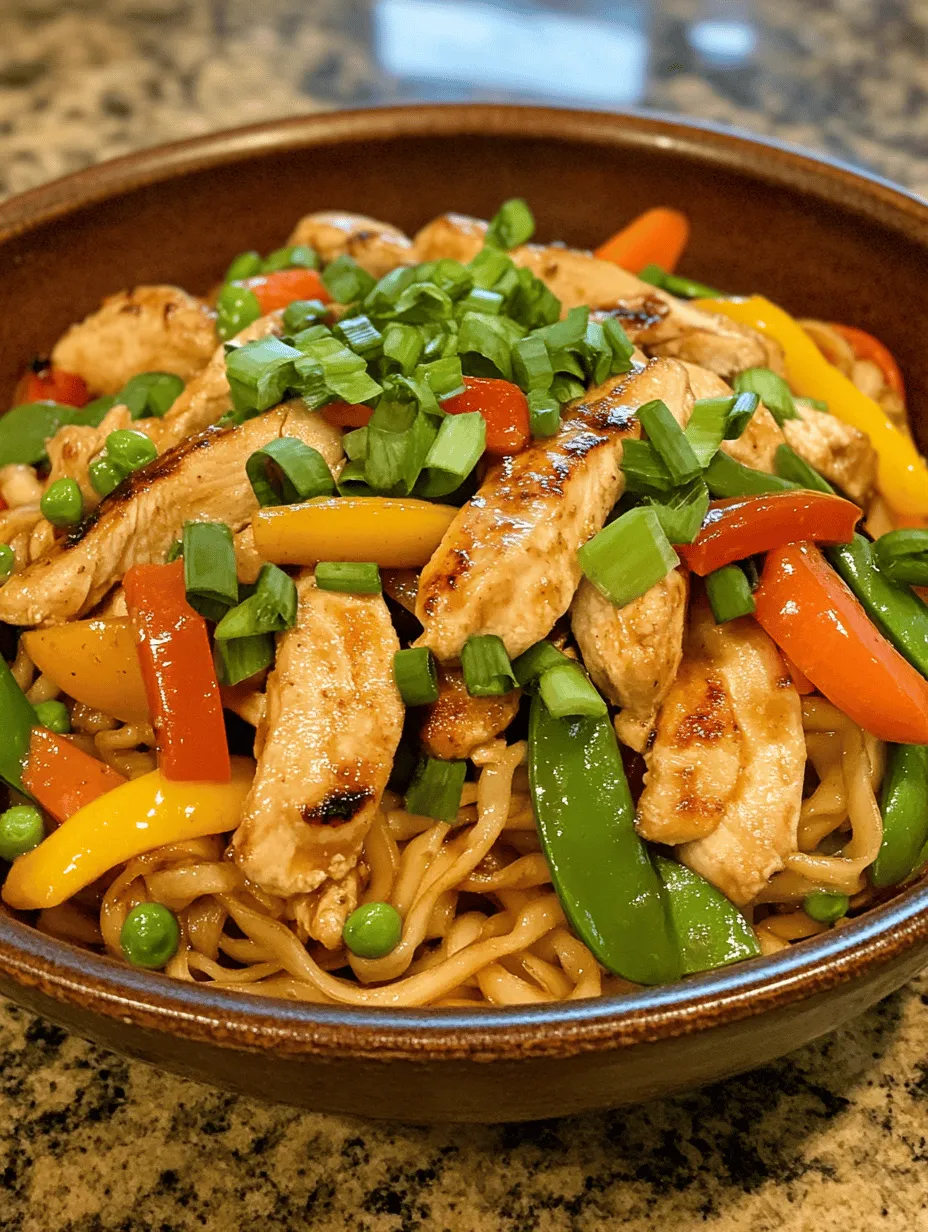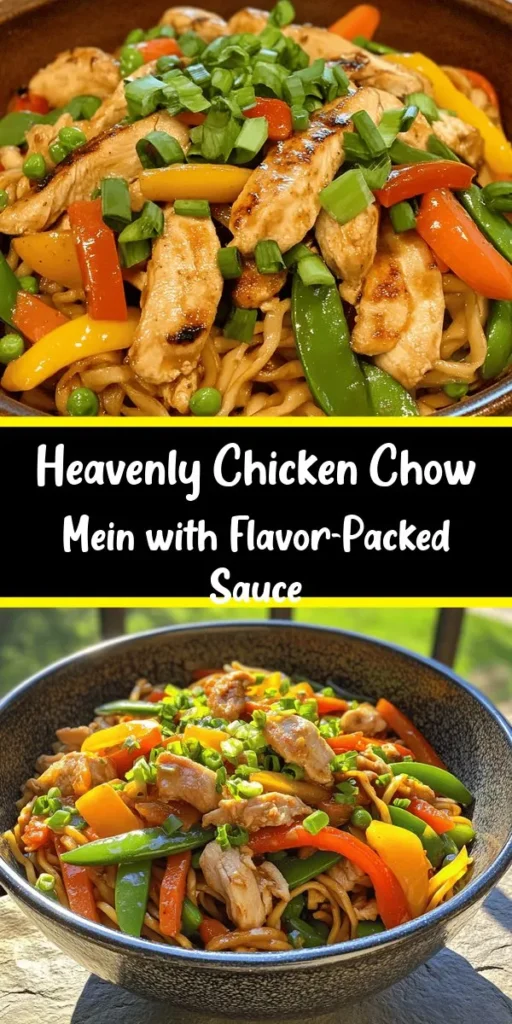Introduction
Chicken Chow Mein is a beloved staple in Asian cuisine, renowned for its delightful combination of textures and flavors. This dish has captured the hearts and taste buds of many around the world, making it a popular choice for both casual weeknight dinners and festive gatherings. What sets this Ultimate Chicken Chow Mein apart is not only its mouthwatering taste but also the ease of preparation. With a savory blend of sauces, fresh ingredients, and high-quality chicken, this recipe allows even novice cooks to create a restaurant-quality meal in the comfort of their own kitchen.
One of the most appealing aspects of Chicken Chow Mein is its versatility. Whether you’re a meat lover or a vegetarian, this dish can be easily customized to suit your preferences. You can swap out chicken for beef, shrimp, or tofu, and you can add a variety of seasonal vegetables to enhance both the flavor and nutritional value. The possibilities are endless, making this recipe a fantastic choice for anyone looking to experiment in the kitchen.
Understanding Chow Mein
Chow Mein, which translates to “stir-fried noodles” in Cantonese, has a rich history that dates back to the late 19th century. Originating from China, this dish has traveled across borders, evolving into numerous regional variations. Traditional Chow Mein is characterized by its stir-fried noodles, typically made from wheat flour, that are crispy on the outside and tender on the inside. The cooking method involves quickly frying the noodles and other ingredients over high heat, allowing for a perfect blend of flavors and textures.
Globally, Chow Mein has taken on different forms, with each culture adding its unique twist. In the United States, for example, you might find a version that includes a variety of vegetables and a thicker sauce, while in other parts of Asia, the dish might lean more heavily on fresh ingredients with a lighter seasoning. Regardless of the variation, the essence of Chow Mein remains the same: a hearty, satisfying meal that brings together the best of stir-fried cooking.
When prepared with fresh vegetables and lean chicken, Chow Mein offers numerous nutritional benefits. The inclusion of colorful vegetables not only adds vitamins and minerals to your diet but also enhances the overall flavor and visual appeal of the dish. Chicken, being a great source of protein, complements the meal by providing essential nutrients that support muscle growth and repair.
Key Ingredients Overview
To create the Ultimate Chicken Chow Mein, you’ll need a selection of key ingredients that work together to deliver an explosion of flavor. Here’s a detailed breakdown of what you’ll need:
Chow Mein Noodles
Chow Mein noodles are the star of the dish. These thin, wheat-based noodles can be found in most grocery stores or Asian markets. There are two main types of Chow Mein noodles: fresh and dried. Fresh noodles are softer and cook more quickly, while dried noodles require boiling before stir-frying. You can also find pre-cooked options that only need a brief stir in the pan. The choice of noodles can affect the texture of your dish, so feel free to experiment based on your preferences.
Chicken Breast
Using chicken breast in your Chow Mein not only adds a delicious source of protein, but it also keeps the dish light and healthy. Chicken breast is low in fat and high in essential vitamins, making it a great choice for a balanced meal. If you’re looking for alternatives, you can substitute chicken with other proteins such as beef, pork, shrimp, or even plant-based options like tofu or tempeh, providing a range of flavors and textures to suit any dietary needs.
Mixed Vegetables
The beauty of Chicken Chow Mein lies in its adaptability to seasonal vegetables. You can use a mix of bell peppers, broccoli, carrots, snow peas, and bean sprouts to create a colorful and nutritious meal. Fresh vegetables not only provide essential vitamins and minerals but also add a satisfying crunch to the dish. When selecting vegetables, consider what is currently in season for the best flavor and freshness.
Essential Sauces
The flavor profile of Chow Mein is heavily influenced by the sauces used in its preparation. Here are the essential sauces you’ll need:
– Soy Sauce: A staple in Asian cooking, soy sauce adds a rich, umami flavor to the dish. It comes in various types, including light, dark, and low-sodium options. For this recipe, a combination of light and dark soy sauce can create a balanced flavor.
– Oyster Sauce: This sauce is known for its slightly sweet and savory taste, enhancing the overall flavor of the Chow Mein. While it contains oyster extracts, there are vegetarian versions available that maintain a similar taste profile.
– Hoisin Sauce: This sweet and tangy sauce adds depth and complexity to the dish. It is often used in Chinese cooking to provide a touch of sweetness and richness.
– Sesame Oil: A little goes a long way, as sesame oil delivers a nutty aroma that enhances the dish’s overall flavor. It should be used sparingly, as its strong flavor can overpower other ingredients.
Understanding the role of each ingredient in your Chow Mein will help you create a more authentic and flavorful dish.
Preparing the Chicken
The preparation of the chicken is a critical step in making your Chow Mein truly exceptional. Marinating the chicken not only enhances its flavor but also ensures it remains tender and juicy during cooking.
Importance of Marinating Chicken
Marinating chicken is a simple yet effective technique that infuses the meat with flavor. By allowing the chicken to soak in a mixture of sauces and spices, you create a depth of flavor that will shine through in your final dish. The marinade also helps to tenderize the chicken, making it more enjoyable to eat.
Step-by-Step Guide to Marinating
1. Choose Your Marinade: For your Chicken Chow Mein, a basic marinade can include soy sauce, oyster sauce, a dash of sesame oil, minced garlic, and a pinch of white pepper. Feel free to adjust the ratios based on your taste preferences.
2. Cut the Chicken: Begin by slicing your chicken breast into thin strips. This will allow the marinade to penetrate the meat more effectively and ensure even cooking.
3. Combine Ingredients: In a bowl, mix your marinade ingredients together. Make sure to taste the mixture before adding the chicken to ensure it meets your flavor expectations.
4. Marinate the Chicken: Add the sliced chicken to the bowl with the marinade. Toss the chicken to coat it evenly, then cover the bowl with plastic wrap or transfer the mixture to a resealable bag.
5. Recommended Duration: For optimal results, marinate the chicken for at least 30 minutes. If you have more time, marinating for 1-2 hours in the refrigerator can deepen the flavors even further. Avoid marinating for too long, as the acidity in some ingredients can start to break down the meat, leading to a mushy texture.
6. Alternative Marinating Ingredients: If you want to explore different flavor profiles, consider adding ginger, chili paste for a spicy kick, or honey for sweetness. Each variation can give your Chow Mein a unique twist.
With your chicken marinated and ready, you’re well on your way to crafting a delicious Chicken Chow Mein that will impress your family and friends.
Crafting the Chow Mein Sauce
The secret to an irresistible Chicken Chow Mein lies in the sauce. A well-crafted sauce can elevate the dish, making every bite a flavorful experience. Here’s how to create the perfect Chow Mein sauce:
Breakdown of Sauce Ingredients
1. Soy Sauce: As mentioned earlier, soy sauce is essential for providing that classic umami flavor. You can use a combination of light and dark soy sauce to achieve a balanced taste.
2. Oyster Sauce: This sauce not only enhances the flavor but also adds a glossy finish to your noodles. It is particularly important for achieving an authentic Chow Mein taste.
3. Hoisin Sauce: The sweetness from hoisin sauce can balance the saltiness of the soy and oyster sauces. Adjust the amount to your liking, especially if you prefer a sweeter dish.
4. Sesame Oil: A drizzle of sesame oil at the end of cooking can add a delightful aroma and richness. Use it sparingly to avoid overwhelming the dish.
5. Spices: Fresh ginger and white pepper can add depth and warmth to your sauce. Ginger provides a zingy freshness, while white pepper adds a subtle heat that complements the other flavors.
Tips for Adjusting Sauce Ingredients
As you craft your Chow Mein sauce, remember that the best sauces are those that suit your taste. Start with the basic ratios and adjust according to your preferences. If you enjoy a sweeter flavor, add more hoisin sauce; for a saltier profile, increase the soy sauce. Don’t hesitate to experiment with different combinations until you find the perfect balance that excites your palate.
With your sauce prepared and your chicken marinated, you are now ready to move on to the cooking process that will bring your Ultimate Chicken Chow Mein to life. Stay tuned for the next section, where we will delve into the cooking techniques that will ensure your dish is nothing short of spectacular.

Stir-Frying: The Heart of Chow Mein
Stir-frying is not only a cooking method but an art form that brings out the best flavors and textures in your ingredients. One of the primary benefits of stir-frying is its speed; the high heat cooks food quickly while sealing in moisture and flavor. To achieve the perfect stir-fry, having the right equipment is essential. A heavy-bottomed wok or a large skillet is ideal, as it distributes heat evenly. Additionally, a spatula or wooden spoon will help you maneuver the ingredients effectively.
When stir-frying, the cooking temperature is of utmost importance. Both chicken and vegetables require a quick sear over high heat to ensure they cook evenly without losing their natural textures. For chicken, achieving a golden-brown exterior while keeping the inside juicy is key. Vegetables, on the other hand, should maintain a vibrant color and crispness, which is best accomplished at high temperatures.
Step-by-Step Guide to Cooking the Chicken
1. Prepare the Chicken: Begin with bite-sized pieces of chicken breast or thigh. Marinate the chicken in a mixture of soy sauce, cornstarch, and a splash of sesame oil for at least 15 minutes to enhance flavor and tenderness.
2. Heat the Wok: Place your wok over high heat and allow it to become very hot. This is crucial for achieving that coveted sear.
3. Add Oil: Swirl in a tablespoon of oil (a high smoke point oil like vegetable or peanut oil works best). Allow it to heat until shimmering but not smoking.
4. Cook the Chicken: Add the marinated chicken in a single layer. Avoid overcrowding the pan, as this can cause steaming instead of searing. Let it cook undisturbed for about 2 minutes before stirring, allowing a nice crust to form.
5. Check for Doneness: Cook the chicken for an additional 3-5 minutes until it is no longer pink in the center. The internal temperature should reach 165°F (75°C). Look for visual cues like a golden-brown exterior and a firm texture.
Step-by-Step Guide to Stir-Frying Vegetables
1. Prep Your Vegetables: Slice your vegetables uniformly to ensure they cook evenly. Common choices for chow mein include bell peppers, carrots, snap peas, and bok choy.
2. Heat the Wok Again: After removing the chicken, add a bit more oil to the hot wok. Make sure it’s hot before adding your vegetables.
3. Stir-Fry in Batches: Start with denser vegetables like carrots and bell peppers, cooking them for about 2-3 minutes. Add quicker-cooking vegetables like bok choy or snap peas later to keep them vibrant and crunchy.
4. Techniques for Maintaining Crunch and Color: Toss the vegetables continuously to ensure even cooking. You want them to be tender-crisp, so cook them just until they turn bright in color and are still slightly firm.
Combining Ingredients for the Perfect Chow Mein
The timing when combining the chicken, vegetables, and chow mein noodles is crucial. Once your chicken and vegetables are cooked, it’s time to add the chow mein noodles and sauce.
1. Add the Noodles: If you’re using pre-cooked chow mein noodles, add them directly into the wok. If using dry noodles, cook them according to package instructions beforehand.
2. Pour in the Sauce: Drizzle your chow mein sauce evenly over the noodles and stir-fry ingredients. This is where you can adjust the flavor by adding more soy sauce, oyster sauce, or a pinch of sugar to balance the flavors.
3. Ensure Even Distribution: Toss everything together quickly to ensure all components are well-coated in sauce. Use a folding motion to lift and mix, avoiding breakage of the noodles.
Final Touches and Presentation
Presentation can elevate your chow mein from a simple dish to a restaurant-quality meal.
1. Garnishing: Top your finished chow mein with freshly sliced green onions, sesame seeds, or cilantro for added flavor and visual appeal.
2. Serving Accompaniments: Consider serving your chow mein with traditional sides such as egg rolls, dumplings, or a light soup. For beverages, pair it with jasmine tea or a crisp white wine.
3. Plating Techniques: Serve the chow mein in a large bowl or platter for family-style dining, or plate individual portions. Use a fork to twirl the noodles for a sophisticated look and garnish with a lime wedge or extra herbs for color.
Nutritional Information
Understanding the nutritional value of your dish is essential for maintaining a balanced diet.
– Nutritional Breakdown: A typical serving of Chicken Chow Mein contains approximately 400-500 calories, with protein from the chicken, fiber from the vegetables, and carbohydrates from the noodles.
– Health Benefits: Chicken is a lean protein source, while vegetables contribute essential vitamins and minerals. Chow mein can fit well into a balanced diet when made with whole ingredients and served in moderation.
Storing and Reheating Leftovers
To ensure your Chicken Chow Mein maintains its delicious flavor and texture after storage, follow these best practices:
1. Storing: Allow leftovers to cool completely before transferring them to an airtight container. Store in the refrigerator for up to 3 days. For longer storage, consider freezing it in portion-sized containers.
2. Reheating: When ready to enjoy your leftovers, reheat them in a skillet over medium heat with a splash of water or oil to prevent drying out. Stir frequently to ensure even heating without losing that desired crunch.
Cultural Significance
Chicken Chow Mein holds a special place in Asian cuisine and has become a beloved dish in many Western households.
– Cultural Roots: Originating from Chinese cuisine, chow mein has evolved alongside Chinese immigration to the West. It is a reflection of the blending of culinary traditions, adapting to local tastes while preserving its essence.
– Popularity: Today, Chicken Chow Mein is a staple in Chinese restaurants across the globe, often associated with comfort food. Its versatility allows for various adaptations, making it a favorite among families and food enthusiasts.
Conclusion
Chicken Chow Mein is more than just a meal; it’s an experience filled with flavor, texture, and cultural history. This dish appeals to a broad audience due to its ease of preparation, wholesome ingredients, and adaptability. By trying your hand at making this chow mein at home, you not only enjoy a delicious dish but also create an opportunity for family bonding over cooking and shared meals. Embrace the joy of cooking, and let Chicken Chow Mein bring a taste of home to your table.



